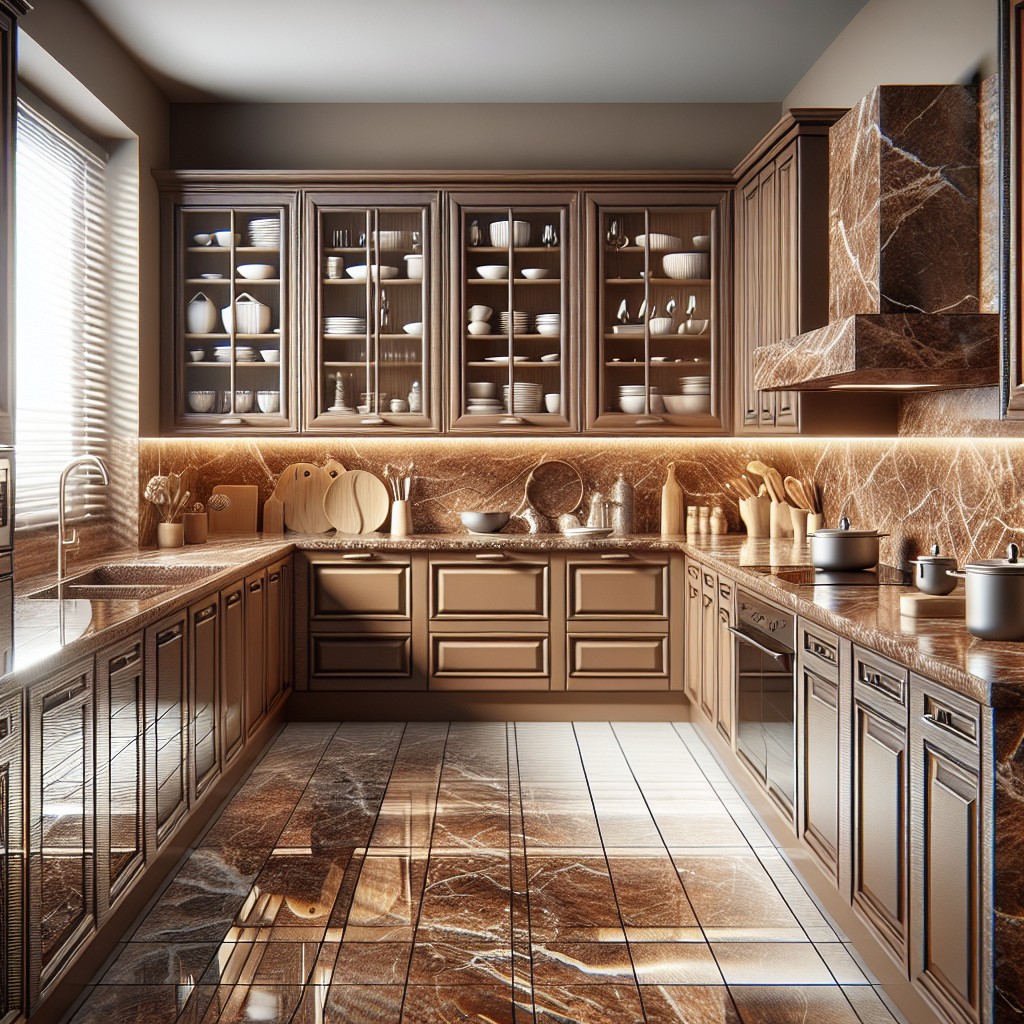Last updated on
Delve into the distinctive world of quartz slabs where we decode the standard dimensions while offering a better understanding of how these sizes cater to different design needs.
Key takeaways:
- Standard quartz slab sizes: 56×120 inches and 54×120 inches.
- Jumbo slabs: 65×130 inches for seamless kitchen islands.
- Super jumbo slabs: Over 65 inches wide and 130 inches long for expansive spaces.
- Custom quartz slab sizes available but come with higher costs.
- Factors to consider: space, overhangs, transportation, budget, design.
What's Inside
Standard Quartz Slab Sizes

When planning your kitchen countertops or bathroom vanity tops, it’s crucial to know the common dimensions available. Typically, slabs come in two sizes: 56 inches by 120 inches, which offers a generous surface area for most projects, and a slightly smaller version, which measures 54 inches by 120 inches.
These dimensions are not arbitrary; they are designed to fit the average kitchen island or counter space, ensuring minimal waste during the installation process. It’s important to note that thickness can vary, usually between 2cm and 3cm, according to design requirements and structural needs.
When considering the size for your project, make sure to factor in overhangs, backsplashes, and seams, especially for larger countertops where multiple slabs may be necessary.
Jumbo Slabs

Jumbo slabs offer an expansive canvas, ideal for kitchen islands and countertops without seams. They typically measure about 65 inches by 130 inches, providing designers and homeowners with more surface area and fewer waste materials. Additionally, fewer seams mean easier maintenance and a more appealing aesthetic.
These oversized slabs have surged in popularity for large open-plan kitchens and commercial spaces, where their grand scale makes a bold design statement. However, it’s crucial to ensure your space can accommodate the size and the installation requires professional handling due to the significant weight.
Super Jumbo Slabs
Moving up the size spectrum, Super Jumbo slabs cater to expansive spaces and minimize seams for a sleek aesthetic. Typically measuring over 65 inches in width and stretching beyond 130 inches in length, their generous proportions are ideal for kitchen islands demanding a continuous surface.
Design enthusiasts revel in the opportunity to extend their creativity with these larger canvases, including applications like full backsplashes and shower surrounds that exude uninterrupted elegance. Efficiency is also a hallmark of Super Jumbo slabs, as their size can potentially reduce waste when cutting pieces for large areas.
It’s worth noting, however, that the heft of these slabs requires thoughtful handling and installation by experienced professionals to ensure safety and preserve structural integrity. The size reflects not just the visual impact but also considerations for transportation and installment logistics; larger slabs may require specific accommodations for maneuvering through space and reinforcing cabinetry.
Custom Quartz Slab Sizes
In the realm of quartz, customization is the creative solution for unique design challenges. If standard slabs fall short, suppliers may offer tailor-made dimensions to cater to specific requirements. It’s essential to keep in mind that opting for a personalized size will naturally affect both the project’s cost and timeline. Here’s why:
- Manufacturing on Demand: Unlike off-the-shelf sizes, custom slabs are produced on a by-order basis, necessitating a unique manufacturing run.
- Waste Material Considerations: Customization often means creating a slab larger than standard offerings, leading to increased material usage and, consequently, higher costs.
- Transportation and Handling: Oversized, non-standard slabs require special considerations for safe transport and installation, again impacting the overall budget.
Remember, while the allure of customization is strong, careful planning and collaboration with your fabricator can help avoid any potential pitfalls.
Factors to Consider When Choosing Quartz Slab Sizes
Selecting the right quartz slab size for your project hinges on several key considerations to ensure both aesthetic appeal and practical efficiency.
Delve into the footprint of your space — larger kitchens or islands may benefit from jumbo slabs, minimizing seams and granting a sleek continuum.
Estimate your surface area and factor in overhangs, as these will dictate the minimum size required.
Transport is another variable often overlooked. Gauge access points to your project site; narrow doorways or tight corners may influence your slab choice.
Meanwhile, sustainability enthusiasts might lean toward smaller slabs to reduce waste, particularly in projects that don’t necessitate vast surfaces.
Budget plays a pivotal role, with larger slabs often commanding a higher price tag. Quoting different sizes can uncover cost-effective alternatives without compromising on quality.
Finally, consider the design and pattern. If you’re enchanted by a slab with dramatic veining or a bold pattern, larger slabs can showcase this uninterrupted, whereas smaller slabs may require precise matching to maintain the design flow across seams.
By taking these factors into account, you can choose a slab size that aligns with your project’s needs, design aspirations, and practical considerations.
Quartz Slab Sizes By Brands
Navigating the variety of quartz slab sizes across different brands can feel like a puzzle. Here’s a snapshot to help you see the big picture:
1. Caesarstone: Known for their durability, they typically offer slabs in sizes around 56.5 inches by 120 inches.
2. Silestone: Their standard slabs come in at a similar range, with a notable size being 55 inches by 120 inches.
3. Cambria: Upscaling luxury, Cambria presents jumbo slabs that reach dimensions up to 65.5 inches by 132 inches.
4. LG Viatera: They cover your needs with slabs available in dimensions of 63 inches by 130 inches.
5. Dekton: While often known for ultracompact surfaces, their quartz slabs also come large, reaching 56 inches by 126 inches.
Each brand balances aesthetic appeal with practical facets of installation and transport. Selecting a slab from a specific brand often depends on your spatial requirements and design vision. It’s important to check availability and whether your chosen fabricator can work with your selected size and brand to bring your project to fruition.
Considerations For Choosing The Correct Slab Size For Your Project
When selecting the right slab size for your project, start by assessing your space. Larger slabs create a seamless look, ideal for expansive areas like kitchen islands, whereas standard sizes are typically sufficient for smaller countertops or bathroom vanities.
Next, consider the layout, including cabinet placement and potential obstacles like sinks or appliances, which may affect slab size and cut.
Budget is another crucial factor. Jumbo and super jumbo sizes may cost more due to their expansive dimensions and reduced seams. Transport and installation are also impacted by size—the larger the slab, the heavier and potentially more challenging to maneuver.
Finally, think about wastage. Choosing a slab that minimizes cut-off waste can be more cost-effective and environmentally conscious. Align your slab choice with the dimensions needed for your project to avoid excess material that won’t be utilized.
It’s wise to consult with your fabricator or designer early. Their expertise can guide you toward the optimal slab size, considering efficiency, aesthetics, and practicality, ensuring your project is both beautiful and functionally tailored to your specific needs.
Classification of Quartz Slab Sizes
When we delve into the classification of quartz slab sizes, we’re essentially categorizing them by their dimensions. Here’s a breakdown:
- Standard Slabs: Typically measuring around 3060 inches in width and 144 inches in length, these slabs are most common in residential kitchen applications.
- Jumbo Slabs: A step up in size, averaging about 65 inches in width by 130 inches in length. These are ideal for larger countertops and reduce the need for seams.
- Super Jumbo Slabs: These behemoths go beyond jumbo, often reaching up to 72 inches wide and 144 inches long. They cater to expansive island countertops and commercial spaces.
Remember, the thickness can vary, usually between 1 cm, 2 cm, and 3 cm. Thicker slabs offer more durability but also increase weight and price. It’s all about finding the perfect balance for your project’s requirements and aesthetics.
Quartz Slab Sizes By Brand for Effortless Design Planning
Navigating through various brand offerings allows you to handpick the perfect slab size for your project. Caesarstone, for instance, typically offers slabs around 56.5 inches by 120 inches. Silestone, on the other hand, might present larger jumbo sizes that can reach dimensions of 63 inches by 128 inches. Cambria boasts an impressive range with some slabs hitting the mark at 65.5 inches by 132 inches, ideal for sprawling kitchen islands.
These distinctions matter greatly when you’re plotting out countertops, considering not just the surface area, but also minimizing seams and waste. If you’re working on a vast kitchen project, a larger slab by a brand like Cambria may be more cost-effective, as it could cover the entire space seamlessly. For bathroom vanities or smaller kitchen areas, the more moderate dimensions from Caesarstone might fit the bill perfectly.
Remember, while the dimensions are crucial, so too is the thickness, which often varies from 1 cm to 3 cm depending on the brand and intended application, affecting both aesthetics and durability. Always coordinate with your fabricator to ensure the model and brand you select align with your design aspirations and functional needs.
FAQ
Do you buy the whole slab of quartz?
Yes, you typically have to buy the whole slab of quartz for countertop installation, except in rare cases where the supplier and fabricator are the same party, where it might be priced by the square foot.
How much does a quartz slab measure?
A typical quartz slab typically measures approximately 120 inches in length and 60 inches in width.
How big is a slab of Silestone quartz?
A slab of Silestone quartz can either be in standard dimensions of 55 inches by 120 inches or in jumbo size dimensions of 63 inches by 128 inches, with thickness options of 1.2 cm, 2 cm, or 3 cm.
What is the thickness range for a typical quartz countertop slab?
A typical quartz countertop slab typically ranges between 2 cm and 3 cm in thickness.
How does the size of a quartz slab affect its price?
The size of a quartz slab directly impacts its price, as larger slabs often cost more due to the additional materials and processing required.
Is there a significant weight variation between different quartz slabs?
Yes, there can be a significant weight variation between different quartz slabs based on their size, thickness, and the specific type of quartz.




